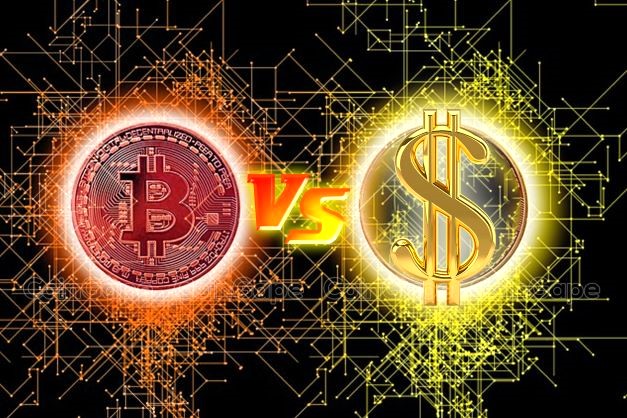Cryptocurrency vs Fiat Currency: In a world where digital innovation continues to shape our lives, the financial landscape has not been immune to change. Cryptocurrency, a digital or virtual form of currency, has emerged as a disruptor in the financial sector, challenging the traditional fiat currency system. This article delves deep into the realm of cryptocurrency, compares it with fiat currency, and explores the implications of this financial revolution.
Understanding Cryptocurrency
Cryptocurrency is a digital or virtual form of currency that relies on cryptography for security. Unlike traditional currencies issued by governments, cryptocurrencies are decentralized and exist solely in electronic form. Bitcoin, Ethereum, and Ripple are some of the most well-known cryptocurrencies, and they have gained considerable popularity in recent years.
Advantages of Cryptocurrency
Cryptocurrencies offer several advantages, including:
Decentralization:
Cryptocurrencies operate on blockchain technology, which means that no single entity or government has control over them. This decentralization can reduce the risk of government interference or inflation.
Security:
Cryptographic techniques make cryptocurrencies highly secure. Transactions are recorded on a public ledger, ensuring transparency and reducing the risk of fraud.
Accessibility:
Cryptocurrencies can be accessed and used globally, making cross-border transactions more efficient and cost-effective.
Ownership:
When you own a cryptocurrency, you have full control over it. There are no third-party intermediaries, such as banks, involved.
Challenges of Cryptocurrency
While cryptocurrencies offer various advantages, they also come with their set of challenges:
Volatility:
Cryptocurrencies are known for their price volatility, which can lead to substantial gains or losses for investors.
Lack of Regulation:
The absence of regulatory oversight can make cryptocurrencies a breeding ground for illegal activities, such as money laundering and fraud.
Limited Acceptance:
Not all businesses and individuals accept cryptocurrencies as a form of payment, which limits their usability.
The Role of Fiat Currency
Fiat currency, on the other hand, is the traditional currency issued and regulated by governments. It includes physical cash, such as banknotes and coins, as well as digital forms of currency maintained by central banks.
Advantages of Fiat Currency
The advantages of fiat currency include:
Stability:
Governments and central banks aim to maintain price stability, reducing the risk of rapid value fluctuations.
Legal Tender:
Fiat currency is universally accepted as a medium of exchange, ensuring its usability for day-to-day transactions.
Regulation:
Government oversight helps combat illegal activities and ensures consumer protection.
Historical Trust:
Fiat currencies have a long history of use, which has led to a high level of trust among consumers.
Challenges of Fiat Currency
Fiat currency faces its own set of challenges:
Inflation:
Governments can print more money, potentially leading to inflation and reduced purchasing power.
Centralized Control:
Governments have the authority to manipulate the money supply and impose capital controls.
Banking System Dependency:
The traditional banking system is necessary for many financial transactions, leading to fees and delays.
Cryptocurrency vs. Fiat Currency: A Comparative Analysis
To understand the differences between cryptocurrency and fiat currency, it’s essential to consider various factors:
Transparency and Security
Cryptocurrency’s blockchain technology offers unparalleled transparency and security. Transactions are recorded on a public ledger, making it difficult for fraud to occur. Fiat currency, while secure, may involve more intermediaries, potentially introducing vulnerabilities.
Accessibility and Inclusivity
Cryptocurrencies, with their borderless nature, are accessible to anyone with an internet connection. In contrast, fiat currency’s accessibility may be restricted by geographical and institutional factors.
Volatility vs. Stability
Cryptocurrencies are known for their price volatility, which can be a double-edged sword for investors. On the other hand, fiat currency tends to be more stable, making it a safer choice for risk-averse individuals.
Regulatory Oversight
Fiat currency is subject to strict government regulation, which can offer consumer protection but also result in government interference. Cryptocurrencies, being decentralized, lack such regulation, which can lead to concerns about illegal activities.
The Future of Finance
The rise of cryptocurrency has ignited a debate about the future of finance. While cryptocurrencies offer numerous advantages, they are not without their challenges. Similarly, fiat currency has been the bedrock of the financial system for centuries, and its stability and widespread acceptance continue to be appealing.
The coexistence of cryptocurrency and fiat currency is likely to persist. As technology and regulatory frameworks continue to evolve, we can expect a more harmonious financial ecosystem that combines the best of both worlds. The future of finance is one where individuals have the freedom to choose the currency that best suits their needs, whether it’s the digital innovation of cryptocurrency or the stability of fiat currency.
Conclusion
In conclusion, the choice between cryptocurrency and fiat currency depends on individual preferences, risk tolerance, and financial goals. Both have their unique strengths and weaknesses, and the ultimate decision should be driven by a thorough understanding of these factors.
